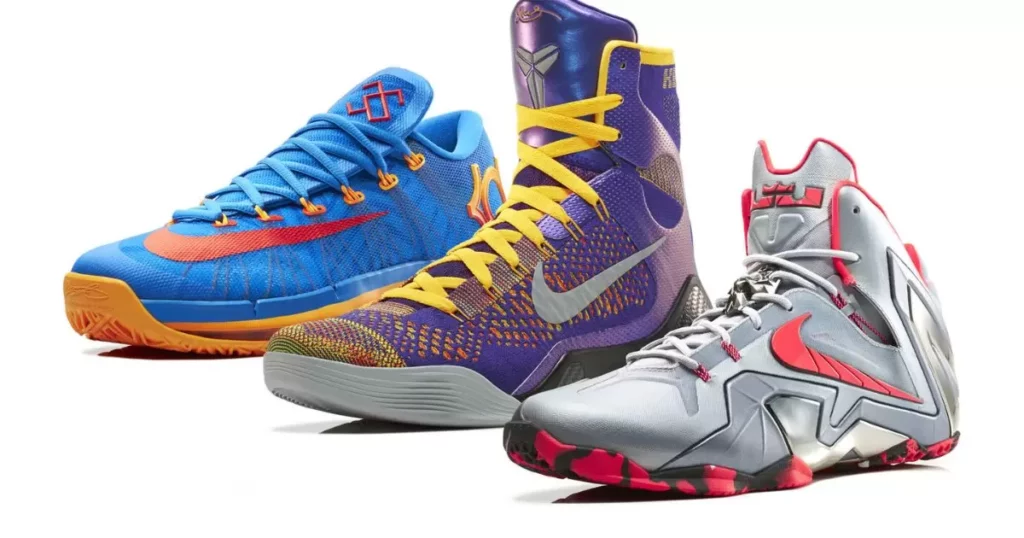Running and basketball are two distinctly different sports, each with its own set of requirements and demands on footwear. When it comes to athletic shoes, these distinctions become crucial. Basketball shoes are purpose-built for the court, offering support, stability, and traction. On the other hand, running shoes are designed for forward motion, cushioning, and comfort during extended periods of exercise. The question that often arises is whether it’s acceptable or even practical to run in basketball shoes. This comprehensive essay delves into this query, examining the characteristics of basketball shoes, the needs of runners, and the pros and cons of running in basketball shoes. By the end of this article, you will have a clear understanding of when it’s acceptable and when it’s not advisable to lace up your basketball shoes for a run.
Characteristics of Basketball Shoes

Before we explore the compatibility of basketball shoes for running and address the question, “Can Basketball Shoes Be Used For Running?” it’s crucial to understand the unique features that define these specialized athletic shoes. Basketball shoes are meticulously designed to meet the demands of the court, with a focus on performance, support, and agility. Here are the key characteristics of basketball shoes:
1. High-Top Design
- Basketball shoes often feature a high-top design, providing enhanced ankle support and stability.
- This design is critical for basketball players who make rapid lateral movements, frequent jumps, and sudden stops on the court.
2. Cushioning and Impact Protection
- Basketball shoes come equipped with substantial cushioning in the sole, specifically designed to absorb high-impact forces during jumps and landings.
- The cushioning helps protect the joints and minimize the risk of injuries, particularly in situations where players land forcefully.
3. Traction
- The outsole of basketball shoes boasts a unique tread pattern optimized for indoor basketball courts.
- This pattern delivers exceptional traction and grip, facilitating quick lateral movements and abrupt stops during games.
4. Durability
- Given the rigorous nature of basketball, these shoes are constructed with durability in mind.
- Reinforced materials and stitching ensure that basketball shoes can withstand the physical demands of the sport over time.
5. Breathability
- Basketball shoes often incorporate breathable materials to regulate temperature and manage moisture.
- This feature ensures that the player’s feet remain comfortable even during extended periods of play.
6. Ankle Support
- The high-top design of basketball shoes not only enhances stability but also provides essential ankle support.
- This support helps reduce the risk of ankle injuries, which can be common in basketball due to the rapid changes in direction.
Running Requirements
Running is a different beast altogether, with specific demands for footwear tailored to long strides, cushioning, and sustained forward motion. Here are the key characteristics that define running shoes:
1. Cushioning and Shock Absorption
- Running shoes are engineered to provide substantial cushioning and shock absorption, ensuring that each stride reduces the impact on the body.
- This is especially critical during long-distance runs, where protecting the joints is paramount.
2. Lightweight Construction
- Running shoes are generally designed to be lighter compared to basketball shoes.
- The reduced weight facilitates more efficient running, requiring less energy for each stride.
3. Breathability
- Running shoes often incorporate breathable materials, promoting comfort by keeping the feet dry and well-ventilated.
4. Flexibility
- The design of running shoes emphasizes flexibility, allowing the foot to move naturally.
- This natural movement is essential for a smooth and efficient stride while running.
5. Tread Pattern
- The tread pattern of running shoes is optimized for forward motion and provides traction on various surfaces.
- Running shoes are versatile enough to accommodate road and trail running, depending on their intended purpose.
6. Ankle Freedom
- Unlike basketball shoes, running shoes do not restrict ankle movement.
- This freedom is vital for the natural articulation of the foot during running, allowing for efficient movement.
Can You Run in Basketball Shoes?
Now that we have a clear understanding of the fundamental differences between basketball and running shoes, we can address the central question: Can you run in basketball shoes? To provide a comprehensive answer, we’ll explore the pros and cons of attempting to run in basketball shoes:
Pros of Running in Basketball Shoes
- Ankle Support: For individuals with a history of ankle injuries or those requiring additional ankle support, the high-top design of basketball shoes can be advantageous.
- Durability: Basketball shoes are built to withstand the stresses of the court, making them relatively durable. This durability can be beneficial when running on uneven terrain or rough surfaces.
- Traction: The traction provided by basketball shoes can offer a solid grip on various surfaces, which may be advantageous if you occasionally run on surfaces other than pavement, such as grass or dirt trails.
- Comfort: Some individuals find basketball shoes comfortable for shorter runs or casual jogs, particularly if they are accustomed to the fit and feel of basketball footwear.
Cons of Running in Basketball Shoes
- Lack of Cushioning: Basketball shoes are not optimized for the level of cushioning and shock absorption required during running, potentially leading to discomfort or injury during extended runs.
- Heavier Design: Basketball shoes tend to be heavier, which can result in increased energy expenditure while running, especially during prolonged runs or races.
- Reduced Flexibility: The stiffness of basketball shoes can limit the natural movement of the foot during running, causing discomfort and inefficiency.
- Shorter Lifespan: Using basketball shoes for running can lead to quicker wear and tear, reducing their lifespan when used on the basketball court.
- Potential Injury Risk: Running in shoes not designed for running increases the risk of various injuries, such as shin splints, stress fractures, and knee pain, due to inadequate cushioning and support.
Given these considerations, it’s evident that running in basketball shoes comes with both advantages and disadvantages. While there are specific scenarios where it may be acceptable, such as casual jogging or when extra ankle support is needed, it’s generally not recommended for dedicated runners seeking optimal performance and injury prevention.
When Is It Acceptable to Run in Basketball Shoes?
While it’s advisable to use running shoes for running due to their specialized design, there are certain situations where running in basketball shoes may be acceptable. Let’s explore these scenarios:
1. Casual Jogging or Short Runs
For those engaging in occasional, short jogs or light running as part of a warm-up routine, basketball shoes can provide ample support and comfort.
2. Ankle Support Requirements
- Individuals with a history of ankle injuries or those who need extra ankle support may find that the high-top design of basketball shoes helps prevent injury during running.
3. Variety of Surfaces
- If your running routes encompass various terrains, including indoor tracks, pavement, grass, and dirt trails, the traction of basketball shoes can be advantageous.
4. Basketball-Specific Training
- Basketball players looking to incorporate running into their training regimen might opt for using basketball shoes for running. This allows for seamless transitions between running and on-court activities.
5. Experimentation
- Some runners occasionally experiment with different types of footwear to understand how they affect their performance and comfort. Running in basketball shoes can be part of such experimentation, provided it’s done cautiously and for limited durations.
It’s important to note that these scenarios are exceptions and not the rule. Dedicated runners who prioritize performance, comfort, and injury prevention should invest in running-specific shoes designed to meet the unique demands of the sport.
Selecting the Right Footwear for Your Activity
Choosing the appropriate footwear for your activity is essential to ensure comfort, performance, and injury prevention. Below is a table summarizing the key differences between basketball shoes and running shoes to help you make an informed decision:
| Feature | Basketball Shoes | Running Shoes |
| Design | High-top design for | Low-cut and versatile |
| ankle support | design | |
| Cushioning | Abundant cushioning in | Ample cushioning with |
| the sole | shock absorption | |
| Traction | Specialized tread | Versatile tread pattern |
| pattern for indoor | for forward motion on | |
| courts | various surfaces | |
| Durability | Built to withstand | Focus on lightweight, |
| court demands | breathable materials | |
| Ankle Support | Provides extra ankle | Freedom of movement in |
| support | the ankle | |
| Weight | Generally heavier | Lightweight for |
| compared to running | efficiency | |
| shoes |
This table summarizes the fundamental differences between basketball shoes and running shoes, highlighting the unique characteristics and purposes of each type of footwear. When deciding on the right shoes for your activity, consider the specific requirements of your sport or exercise routine.
Conclusion
In conclusion, the question of whether you can run in basketball shoes is nuanced. While it’s possible to run in basketball shoes, it’s not always advisable, and there are distinct advantages and disadvantages to consider. Basketball shoes are purpose-built for the demands of the court, emphasizing support, stability, and traction. In contrast, running shoes are engineered for forward motion, cushioning, and long-term comfort. Therefore, it’s generally recommended that dedicated runners invest in running-specific footwear to optimize their performance, reduce the risk of injury, and ensure long-term comfort.
However, there are specific scenarios where running in basketball shoes may be acceptable, such as casual jogging, short runs, or situations where extra ankle support is necessary. Basketball players looking to incorporate running into their training can also consider using their basketball shoes, as this allows for seamless transitions between activities.
In the end, the choice of footwear should align with your specific needs and goals. Whether you opt for running shoes or basketball shoes, make an informed decision that prioritizes your performance, comfort, and overall well-being. Remember that the right footwear can significantly enhance your athletic experience and help you achieve your fitness goals while minimizing the risk of injury.



